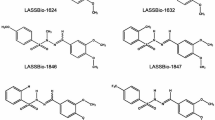Abstract
This study describes a rapid in vitro assay for the order of potency of bronchodilator drugs using specific binding of (−)-[3H] dihydroalprenolol ([3H]DHA) to rat lung membranes. Under linear conditions with respect to tissue, specific binding of [3H]DHA showed saturability, rapid kinetics of association and dissociation of radioligand, and sterospecificity. Nanomolar (nM) concentrations for 50% inhibition (IC50±SE) for the bronchodilator drugs examined were as follows: albuterol, 1485±170; isoproterenol, 136±53; procaterol, 162±28; terbutaline, 3310±934; and zinterol, 51±8.3. A comparison of binding studies using rat lung tissue membranes and similar preparations of rat heart and skeletal muscle demonstrated that lung tissue had 7 to 8 times more receptor sites (Bmax) for [3H]DHA than heart or skeletal muscle. Adenyl cyclase activit of the rat lung membrane preparation almost doubled in the presence of (−)-isoproterenol. Displacement of specific (3H)DHA binding in membrane preparations may provide useful data for evaluating bronchodilator compounds.
Similar content being viewed by others
References
Barnes PJ, Karliner JS, Dollery CT (1980) Human lung adrenoceptors studied by radioligand binding. Clin Sci 58:457–461
Bennett JP Jr (1978) Methods in binding studies. In: Yamamura HI, Enna SJ, Kuhar MJ (eds) Neurotransmitter Receptor Binding. Raven Press, New York, pp 57–90
Brown BL, Albano JDM, Ekins RP, Sgherzi AM (1971) A simple and sensitive saturation assay method for the measurement of adenosine 3:5-cyclic monophosphate. Biochem J 121:561–562
Chen FM, Yamamura HI, Roeske WR (1982) Adenylate cyclase and beta adrenergic receptor development in the mouse heart. J Pharmacol Exp Ther 221:1–13
Chen YC, Prusoff WH (1973) Relationship between the inhibition constant (Ki) and the concentration of inhibitor which causes 50 percent inhibition (I50) of an enzymatic reaction. Biochem Pharmacol 22:3099–3108
Frishman WH (1981) Beta-adrenoceptor antagonists: new drugs and new indications. N Engl J Med 305:500–506
Hazeki O and Ui M (1980) Beta1 and beta2-adrenergic receptors responsible for cyclic AMP accumulation in isolated heart and lung cells. Mol Pharmacol 17:8–13
Lands AM, Arnold AM, Luduena JP, Brown TC (1967) Differentiation of receptor systems activated by sympathomimetic amines. Nature 214:597–598
Larrson S, Svedmyr N (1977) Tremor caused by sympathomimetics is mediated by beta-2-adrenoceptors. Scand J Respir Dis 58:93–102
Lefkowitz RJ (1975) Heterogeneity of adenylate cyclase coupled beta-adrenergic receptors. Biochem Pharmacol 24:583–590
Levy B. (1966). The adrenergic blocking activity of N-tert-butyl methoxamine (butoxamine). J Pharmacol Exp Ther 151:413–422
Lowry OH, Rosebrough NJ, Farr AI, Randall RJ (1951) Protein measurement with Folin phenol reagent. J Biol Chem. 193:265–275
Minneman KP, Hegstrand LR, Molinoff PB (1979) Simultaneous determination of beta-1 and beta-2-adrenergic receptors in tissues containing both receptor subtypes. Mol Pharmacol 16:34–46
Minneman KP, Hegstrand LR, Molinoff PB (1979) Comparison of beta-adrenergic receptor subtypes in mammalian tissues. J Pharmacol Exp Ther 211:502–508
O’Donnell SR (1972) An examination of some beta-adrenoceptor stimulants for selectivity using the isolated trachea and atria of the guinea pig. Eur J Pharmacol 19:371–379
Rugg EL Barnett DB, Nahorski SR (1978) Coexistence of B1 and B2-adrenoceptors in mammalian lung: evidence from direct binding studies. Mol Pharmacol 14:996–1005
Williams LT, Lefkowitz RJ (1978) Receptor binding studies in adrenergic pharmacology. Raven Press, New York, pp 5–17
Williams LT, Snyderman R, Lefkowitz RJ (1976) Identification of beta-adrenergic receptors in human lymphocytes by [3H] alprenolol binding. J Clin Invest 57:149–155
Young RR, Growdon JH, Shahani BT (1975) Beta-adrenergic mechanisms in action tremor. N Engl J Med 293:950–953
Author information
Authors and Affiliations
Rights and permissions
About this article
Cite this article
Fleisher, J.H., Pinnas, J.L. In vitro studies on the relative potency of bronchodilator agents. Lung 163, 161–171 (1985). https://doi.org/10.1007/BF02713818
Accepted:
Issue Date:
DOI: https://doi.org/10.1007/BF02713818




